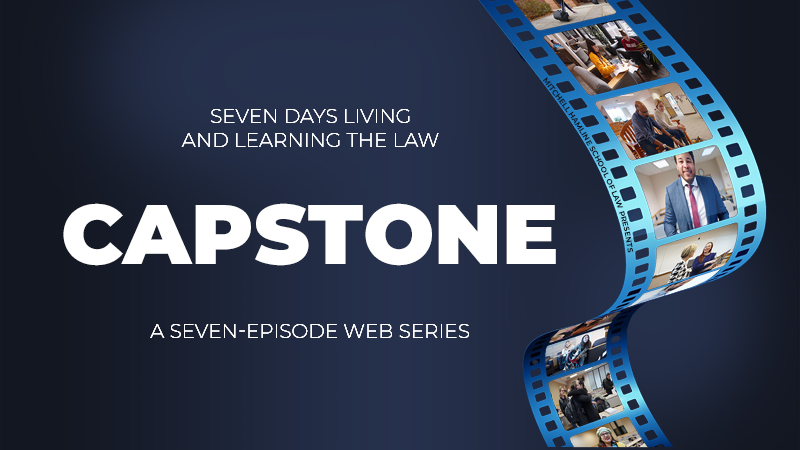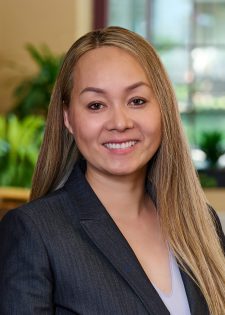We do online legal education right—on your time
Mitchell Hamline’s blended-learning option combines the best of distance learning with the best of in-person instruction.
We understand that the greatest benefit of online education is that we can make it fit your life. All of your online legal education is done on your time. You decide the best way to schedule your time to meet the deadlines and work requirements.
Follow two cohorts of blended learning students through Fall Capstone Week
-
A timeline of blended learning at Mitchell Hamline
Early 2000s
Faculty begin offering online components and blended learning courses. The technology of the day is limiting but improves steadily as online education grows in higher education.
February 2010
Library director and faculty member Simon Canick presents Online Learning: Directions for Legal Education to various campus constituencies showing the growth of online learning at the undergrad level and proposing the school offer a four-year, part-time Hybrid J.D.
Spring 2012
Professor Greg Duhl, in the law review’s Contemporary Issues in Outcomes-Based Legal Education issue, praises the “high level of success with faculty development and implementation of blended courses” and calls for “technological flexibility in the form of additional online and blended courses.”
July 2013
Formal request submitted to the American Bar Association seeking a variance to offer the Hybrid J.D.
September 2013
American Bar Association Task Force on the Future of Legal Education calls on law schools to change and innovate.
December 2013
ABA approves variance for 96 students per year to be admitted to Hybrid J.D.
February 2014
New scholarships available to students in rural America, small towns, and Indian reservations who have been admitted to the Hybrid J.D.
September 2014
A team of our professors, educational technologists, and law librarians host the Working Group for Distance Learning in Legal Education on our St. Paul campus.
January 2015
85 pioneering students from across the country begin the nation’s first hybrid on-campus/online program at an ABA-approved law school.
June 2017
Mitchell Hamline a world champion in International Negotiation Competition
Two blended-learning students, based a thousand miles apart in Texas and Minnesota, outperform 32 teams from 25 countries to win the International Negotiation Competition for Law Students in Oslo, Norway.August 2017
With demand outpacing the 96-student cap for the Hybrid J.D., Mitchell Hamline develops two additional blended-learning options with more in-person hours than the Hybrid J.D. The new programs offer significant online learning but make use of innovative in-person time, including a new Weekend Workshop model. One, called the Executive option, is modeled on the Hybrid J.D., while the other is a new version of the school’s traditional Weekend option.
January 2018
The first graduates of the Hybrid J.D. join the ranks of Mitchell Hamline’s 20,000 alumni. They are from the first and second cohorts and completed the four-year program in two and a half to three years.
March 2019
For the first time, a blended learning student—Amber Fitzgerald from Washington, Missouri—was elected editor in chief of the Mitchell Hamline Law Review.
Summer 2019
The number of blended-learning graduates from Mitchell Hamline was over 160 and counting, and our blended-learning alums are licensed and practicing in states across the nation.
Fall 2020
Mitchell Hamline launches a single blended option that builds on the strengths of Hybrid, Executive, and Weekend options. The new blended learning enrollment offering retains the increased on-campus time, prepares graduates to take the bar exam in all 50 states, and allows students to control their online work schedule and customize the duration, content, and format of their degree.
July 2021
Mitchell Hamline students win global negotiation competition
Austyn Boothe and Daniel Sheikhan win the International Negotiation Competition, marking the second time in four years that Mitchell Hamline blended-learning students have claimed the top global prize.
-
Praise for the first-of-its-kind Hybrid J.D.
The launch of the Hybrid J.D. program drew much praise from the legal community, including the following:
- One of the “10 Most Promising Innovations in Legal Education.” preLaw magazine
- “This pretty much puts [Mitchell Hamline] on the cutting edge of legal education.” Lawyerist
- “…they put a lot of time, thought, energy, creativity and resources into developing the plan. The grant [of a variance in the number of on-line hours the school can offer] shows the program was carefully considered and carefully constructed.” Barry Currier, managing director of accreditation and legal education for the ABA
- Former president and dean Eric S. Janus, who led the initiative to gain the ABA variance for the Hybrid J.D. program was named one of the “Most Influential People in Legal Education” in 2015 and 2016 by the National Jurist.
-
In a student’s words: Responsive, demanding, intense, and accessible
Bethany Lambert, a member of the Hybrid J.D. program’s first cohort, talks about her experience with the program.
“While I am working on my own, I am never really alone. My professors are very responsive, the librarians are helpful and even have an instant message feature, and I am constantly in contact with my classmates, some of whom I count among my closest friends. Additionally, while I may be working at home, I do not have leeway to be anything but disciplined and devoted as the program is demanding. I am being held accountable for all the reading and material through weekly discussion boards and papers. The writing demands of this program are intense.
In-person performance is also emphasized, as the Capstone Week, where we travel to St. Paul for seven days towards the end of each semester, is intense and productive. My cohort has just finished our third semester, and my classmates and I have already been required to argue four motions in oral arguments, participate in two negotiations and one mediation simulation, and conduct several client interviews. Local attorneys and judges serve as our adjudicators and clients in these simulations.
The most remarkable element of the Mitchell Hamline Hybrid J.D. program is its accessibility. My class was asked during a recent ABA evaluation how many of us would be unable to attend law school had it not been for this program. Nearly every hand went up. Personally, as a mother of two special needs children, this program affords me the opportunity to receive a legal education and still tend to my children’s needs.”
Making blended education the equal of the traditional program
Important resources such as academic tutoring, career counseling, and bar exam preparation were made available to all students, no matter their location. Blended learning students can take advantage of the same opportunities as on-campus students. They can serve in student organizations like Law Review, do externships in the communities where they live, and participate in student competitions. Mitchell Hamline makes it possible for blended learning students to work in legal settings in their hometown during law school, which connects them to professionals and trends in their area.
Learn more about the blended-learning program
The first blended-learning graduates describe their experiences.
In-person curriculum
The greatest innovation in the way we provide blended legal education has been on the in-person side. This has been the key to our success as pioneers in modernizing legal education.
Capstone Weeks
The core curriculum is focused on experiential learning. Each semester culminates in an on-campus Capstone Week that emphasizes skills training. Capstone Weeks use real-world simulations to help students build and practice their writing, negotiating, counseling, and trial skills.
Externships
Students also gain real-world experience by completing externships in two semesters, during which they work in the field on real legal problems under the supervision of practicing attorneys in their communities.
Academic Affairs
Academic Affairs oversees the advising initiatives that provide academic direction and degree planning for both blended and on-campus students.
The online and on-campus portions work together
Students in Advocacy, for instance, do depositions as well as direct and cross examinations over Skype or FaceTime and then do a full mock trial when they get to campus. Combining these two learning formats, provides blended learning students with:
- opportunities that balance the online format and the in-person simulations
- interactive practical exercises, both online and in person
- exercises that mimic real-life situations
Students in blended learning courses get feedback constantly, not just at midterm and final exam time. Through the online learning platform students can easily track their progress and see where they need to improve before they get to final exams.
And there are multiple ways for students to connect with one another and with professors. Students are assigned to discussion groups, randomized for every course so each student will likely have substantial online interaction with every other student in their cohort over the course of their law school career. Students engage and interact with each other as much as possible because that’s a key part of law school. This allows them to build a nationwide network of future colleagues.
Educational technology and instructional design
A team of instructional designers facilitates the growth of the blended learning programs. Their main task is to work with professors to transfer what traditionally has been done face-to-face into an online format that maintains not just the rigor but also the interactivity.
Canvas LMS
To offer the best blended legal education, we sought the best learning management system. As faculty, even in our traditional program, began to embrace the use of this technology in their classrooms, we quickly outgrew our original system. Our faculty and educational technologists researched, tested, and eventually chose the best available. Video and other media is integrated into Canvas classrooms via Panopto, a leading video content management system as rated by Gartner.













